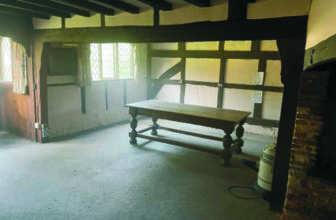
The annual report of the Village Hospital came out at the end of September. During the previous year, 98 patients had been treated and 45 operations performed, with an average stay of 13.6 days.
One of the hospital’s medical staff, Dr Alexander Hope Walker, was away serving with the Royal Army Medical Corps. We know from the 1911 Census that he was 45 then, so he was particularly patriotic to volunteer for active service in his fifties. The picture shows him under the ‘Cranleigh Oak’ on the Common, with a group of recovering patients from the Oaklands Military Hospital, in their distinctive blue- and-red uniform, known as the ‘Blighty Blues’. This is presumably after Dr Walker’s return to Cranleigh in 1917. Dr Walker’s house was ‘East Gables’ on the Common, which is the left-hand two-thirds of what is now Maple Tree House and Kelsham Dental Care.
Doctors or dentists who joined the RAMC received a commission, and were in charge of 80-100 men. Cranleigh man Rennie Crick, of the Northampton Boot Store here, was one of those in the ranks of the RAMC. After service with the 34th Field Ambu- lance in Gallipoli and Egypt, as par t of the 11th Division, he was brought to the Western Front in July 1916.
What struck him on arrival from Egypt was first the rain, and second the large number of aeroplanes, both Allied and German. The 11th Division took over part of the front in the 3rd Army sector, and as the Battle of the Somme continued they were in the thick of the action.
On September 14th Rennie wrote in his diary, ‘the 11th Division charged the Germans at 6 pm and I was working all night taking in casualties’. He took in 278 on the first night. It sounds as though he was working in an Advanced Dressing Station, where wounded men were received, patched up and if necessary passed further back from the front line to a Main Dressing Station or even a Base Hospital.
RAMC doctors treating casualties (photo, Imperial War Museum)
On the 26th, ‘a Big Push started’. Rennie passed 300 casualties through that night, and worked 36 hours non-stop, but the 11th Division succeeded in capturing the town of Thiepval the next day. Thiepval is now the site of a large memorial to the 72,000 who died at the Somme.












